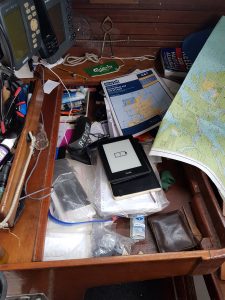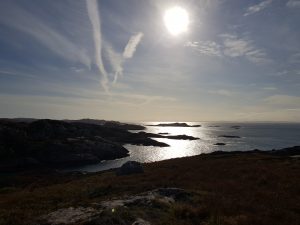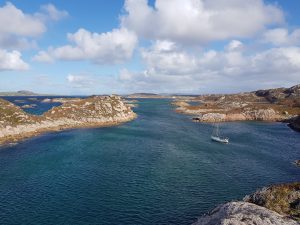Talk about leisurely… all I had to do was get up in time for lunch and then motor the 20 miles to the entrance to the Sound of Islay. There was the little (but magnificently named) Am Far Eilean Bay just at the entrance where you can anchor for the night before catching the tide as it begins its race through the sound after breakfast.
And it does race – five knots at springs.
If you have read my ramblings about ocean calms, you will know that I don’t like to use the engine except for getting in and out of harbour but then, if you have a thousand miles to go, what’s the point?
Twenty miles, on the other hand is a different matter – especially if the difference means having to wait another day for the wind.
I turned the key. The worshipful Nanni rumbled into life with due obedience. This is worth noting because once or twice over the past week or so, it had developed something of a stutter – slowing down before resuming its business (and increasing my heart rate at the same time).
Anyone would think this was a fuel blockage. I know all about fuel blockages. What happens is that the stuttering becomes more frequent until eventually the engine stops and you have to turn the key again. Eventually, if nothing is done, obedience goes out of the window.
We hadn’t reached that stage yet. Sometimes you never do. But it was something to keep an eye on as we puttered out of the bay and through the little passage inside the island of Texa (or Caolas an Eiolein) as I had learned to call it.
It’s fairly dull business, motoring. I suppose that’s the reason motor cruisers go so fast, creating enormous wakes that shake the wind out of sails – motorboat drivers can’t wait to get somewhere.
I didn’t have the luxury: Putt-putt-putt at four-and-a-half knots past the Laphroaig distillery and the Lagavulin distillery (they have their names painted on their walls in enormous letters), each with it’s plume of blue peat smoke hanging in the air.
To seaward, the Mull of Kintyre was a sort of purple colour on the horizon. They’re certainly right about the scenery up here. I would have liked to see a submarine, though – apparently they’re as common as seals because of the base at Faslane. All I got was another yacht going the other way – a Halberg-Rassey with it’s distinctive blue stripe and reinforced windscreen. About 35ft at a guess – and it had to be a guess because he didn’t have his AIS switched on; that would have told me… and his name too…
It was past teatime when we got to the entrance to the sound and the engine stopped.
It stuttered once and then stopped – and this time, it didn’t start again.
Now, a loss of power shouldn’t worry a sailing boat – unless it happens in the middle of a tricky manoeuvre in a marina surrounded by a lot of gleaming potential insurance claims or, perhaps, in a narrow channel strewn with rocks and with a five knot tide running just when a flat calm renders the sails useless.
And it did. There was not even a ripple as Samsara glided slowly to a halt.
Of course, she didn’t really glide to a halt. She just halted in the water – and the water was moving inexorably into the Sound.
Obviously, I turned the key again. The engine groaned but didn’t chug.
I checked the tank: Nearly full. I checked the glass bowl under the first fuel filter – yes, full of fuel with a tiny layer of water at the bottom where it should be. What else could I do? I have little expertise in electrics – but once the starter-motor starts turning, a diesel doesn’t need electricity. Could it be the fuel pump? If it was, what could I do about it here and now?
And come to that “here” was not where it had been. Before I removed the engine casing and started peering into the mysteries within, we had been moving at 0.3knots into the Sound. By the time I emerged having achieved nothing, this has risen to 0.5.
Admittedly this is far short of the frantic five knots found in the narrows. But it has to work up to that – and quite clearly, the process had begun. What made it alarming was that one of the interesting aspects of the Sound of Islay is Black Rock.
An extraordinary number of places have a Black Rock. Maybe this is because most rocks are, indeed, black – or maybe it just sounds more scary. Falmouth has one in the middle of the harbour entrance.
The Sound of Islay’s black rock and it’s attendant reef is marked by a green buoy to stop people running into it. But, of course, this is only if that someone has some control over where they’re going.
As with all things to do with the sea, there is a correct course of action when you find yourself setting off somewhere but have no control over exactly where and that is to throw out your anchor. Grab a hold of the bottom. Stay put.
I looked at the depth recorder: 42metres. I carry 50 metres of chain so it would reach the bottom but no anchor will hold with the chain vertical – that’s how you get it up. So, I couldn’t anchor. Yet, now the progress up the Sound and in the direction of Black Rock was up to 0.6kts.
What I needed was a tow.
That was how I came to think of the Halberg-Rassey which had been going the other way not a quarter of an hour earlier. In fact I could see him in the distance. Anybody who has a boat like that is bound to be a decent type. He would give me a tow, I was sure of it – take me back into Port Ellen where I could find an engineer. Should I take him a bottle of malt as a thank-you?
Except, of course, he was far too far away to hail – or to see me if I were to stand on the foredeck brandishing a coil of rope which is the sailor’s equivalent of a hitchhiker’s thumb (and worked so well when the engine stopped in a similar calm on my very first outing with Samsara back in 2017).
I would have to call him on the radio. But who to call? If his AIS had been switched on, I would have known his name. As it was, I could hardly broadcast: “Halberg-Rassey sailing yacht to the south-east side of Islay, possibly making for Port Ellen….”
I could do an “All ships” broadcast. Maybe there would be another yacht about – or a kindly fisherman…But in that case, I would have to announce that I required assistance: The correct procedure would been to preface it with “Pan-Pan” which is the radio code for “Urgency” just as “Mayday” is “Emergency”. The trouble with that is that it all begins to become rather official and the next thing you know, the Coastguard will get involved and the Coastguard’s default procedure is to call out the Lifeboat.
I didn’t want the Lifeboat. I would die of shame.
On the other hand the little red arrow on the screen was still pointing resolutely into the Sound – and in the Sound was Black Rock – waiting… (possibly salivating…)
I stood in the companionway, the engine casing open in front of me, the VHF radio switched on. Channel 16, the calling channel, glowing on the screen.
That was when I asked myself what was the sensible thing to do. Forget dying of shame and being self-sufficient and taking responsibility and all that. What was the sensible thing to do?
It was a question I have grown very used to over the past three years: The boat is pounding into a rising wind and sea, every elderly joint is protesting, the rigging is bar-taught. Reefing means you must struggle into foul-weather gear and go crawling up the deck to reef. What is the sensible thing to do?
Or you have returned too late and find the dinghy on the other side of the sand bar which separates St Agnes from The Gugh in the Isles of Scilly. The tide is racing across it, already thigh-deep and doing four knots. The book says it is dangerous to attempt a crossing at such times. What is the sensible thing to do?
You are helpless, becalmed and with no engine. You are being sucked into a ten mile stretch of water, only half a mile wide at its narrowest – and if there is a chance of missing black rock on the way up, remember the tide will turn in two hours and sweep you back again for another go… and by the way it will be dark by then…
What is the sensible thing to do?
I took the microphone and thumbed the Transmit button: “Pan-Pan…”
To give Belfast Coastguard their due, they waited for my second broadcast and then a few minutes after that to see if any of the “all ships” might offer a tow before they waded in and “tasked” the Islay Lifeboat to come to my assistance.
Of course, once I knew I was saved, I regretted most bitterly causing such a fuss. If I could have done it without the certainty of even more embarrassment, I would have called again and told them to cancel everything – rather as one were deciding not to go out for dinner after all and so wouldn’t be needing a taxi home.
Instead, while I waited, I dismantled the fuel filter and found it as clean as when it came out of the box.
Then the Lifeboat arrived and passed me a hawser as thick as my wrist. They would take me to Port Askaig, they told me. The little ferry port is half way up the sound. With the tide, it took no time at all, keeping to the west side, away from Black Rock and warping me round with utmost efficiency to lie again the harbour wall.
The shore crew were there, of course – all the guys who hadn’t made it in time for the launch. As with all lifeboats crewed by volunteers and supported by public donations, everyone was as friendly and helpful as could be – and also, as understanding when I kept on embarrassing myself by saying how embarrassed I was and how sorry to have troubled them. I had panicked, I said – the five knot tide… Black Rock…
“Oh aye,” they told me. “Black Rock. That’s no place to be around without your engine…”
Come to that, was there an engineer in Port Askaig?
“Oh aye, we’ll send Peter to you. Peter’s from the garage. He’s our mechanic.”
And sure enough, half an hour later, Peter appeared. He would be glad to have a look. Would tomorrow morning at 7.15 suit me?
Well, if it wasn’t too early for him…
I spent a miserable night of recriminations. How is it that only after the event, you realise what you should have done?
Of course I could have anchored – not with the 20kg bower anchor and the 50metres of chain but with the lightweight kedge. It’s an aluminium Fortress with amazing holding power and designed to be used with just a short length of chain and then rope on a 5:1 scope – which, at the point when the engine stopped, meant that I would have needed 210 metres of rope. It sounded an awful lot. But I could manage to find 210 metres from somewhere, surely. Think about it: 50 metres of its own warp, plus 30 metres for the drogue I lost off Guernsey last year. Then I had two 15metre spinnaker sheets, various mooring warps totalling another 45metres. I could take off the mainsheet. That must be 20 metres… nearly there. What else have I got? There’s some skanky old stuff at the bottom of the Lazarette – say 20 metres in all. That takes me to 175… I’ve got miles of 8mm line but you can’t anchor a five tonne boat on 8mm. Of course! I had the headsail sheets, each of those is ten metres – that’s 195. Come on, come on, there must be another 15 metres somewhere. How about the topping lift – I could always go up the mast and put it back later…
Of course I could have anchored and waited for the wind. I’d have been fine – and then, when the wind returned, I could have sailed back to Port Ellen – even if it was dark. And there would be a mechanic there in Port Ellen. He might have a boat of his own to come out and see me – or surely I could organise a tow into the marina…
By the time I’d dwelt on all this and done the arithmetic, my brain would not let me go back to sleep – still, Peter was turning up a 7.15…
At seven o’clock, I had the engine casing off and everything ready for him to fix.
By 7.30, there was no sign of him – and I was beginning to think how much more embarrassing this could get if he turned up and the engine started. I ought to try it.
Of course it did start. It ran as smoothly as ever. I let it run, almost willing it to stutter and stop. But now, as Johnny Cash would have said, that engine ran just like a song.
There was nothing for it, I had to call and cancel Peter: There is nothing more difficult for a mechanic than finding a fault when it’s not there. But I didn’t have Peter’s number. There were people in the Lifeboat building, none of them remotely surprised that Peter had not turned up – and now he would have started on his day’s work at the garage…
On the phone he was as affable as ever – and pleased the problem seemed to be solved.
More to the point, it was still early enough to take the last two hours of tide out of the sound and get to Tinker’s Hole before a North Westerly gale arrived tomorrow.
It was only after I had cast off and was manoeuvring backwards that the engine stopped…










Well what a guy! To keep on revisiting the race like that, such determination.
Really hope he makes it this time.
Alex Thompson – Awesome! How one person can handle/race a machine like that in the Southern Ocean is beyond my comprehension.
Thanks for alerting us to the Vendee Globe John. Happy memories of Ellen M doing it. Shall now follow Alex starting Nov 8